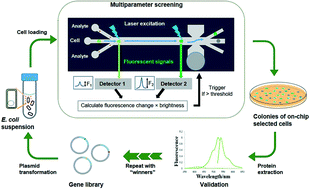A single-phase flow microfluidic cell sorter for multiparameter screening to assist the directed evolution of Ca2+ sensors†
Abstract
We introduce a single-phase flow microfluidic cell sorter with a two-point detection system capable of two-parameter screening to assist with directed evolution of a fluorescent protein based Ca2+ sensor expressed in bacterial cells. The new cell sorting system utilizes two fluorescence microscopes to obtain signals at two different points along a flow path in which a change in concentration of the analyte, Ca2+, is induced. The two detectors thus determine the magnitude of fluorescence change of the sensor following the reaction, along with the overall brightness of the sensor. A design for a 3D focusing flow was configured to enhance the spatial control of cells and signal pair-matching. The cell sorter screens the sensors at a moderate throughput, 10 cells per s and 105 cells per round, enriching top variants for the subsequent manual screening with higher accuracy. Our new μFACS greatly accelerates the directed evolution of genetically encoded Ca2+ sensors compared to the previous version with single point detection for brightness-based screening. Two rounds of directed evolution led to a variant, named Y-GECO2f, which exhibits a 26% increase in brightness and a greater than 300% larger Ca2+-dependent fluorescence change in vitro relative to the variant before evolution.



 Please wait while we load your content...
Please wait while we load your content...